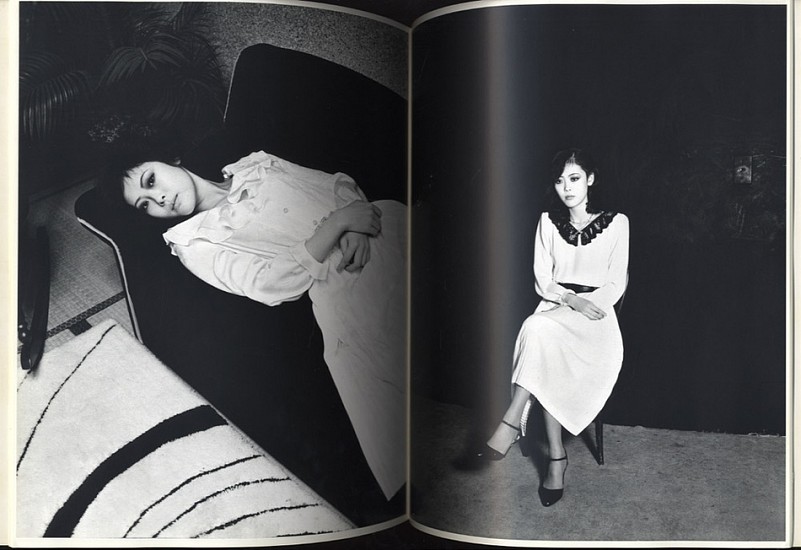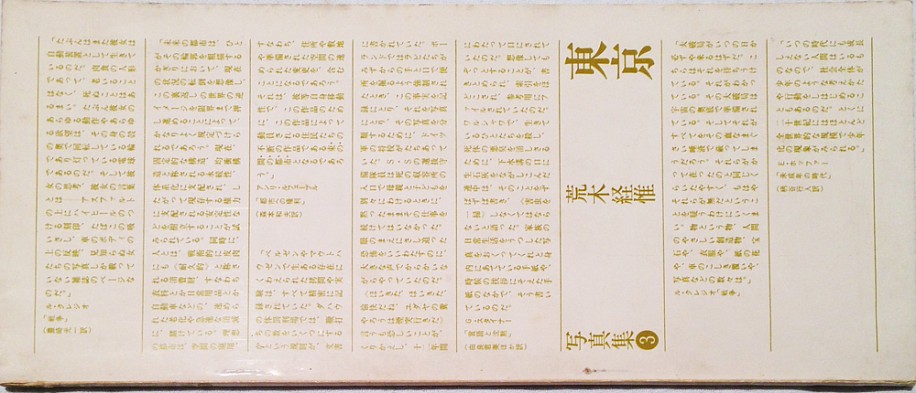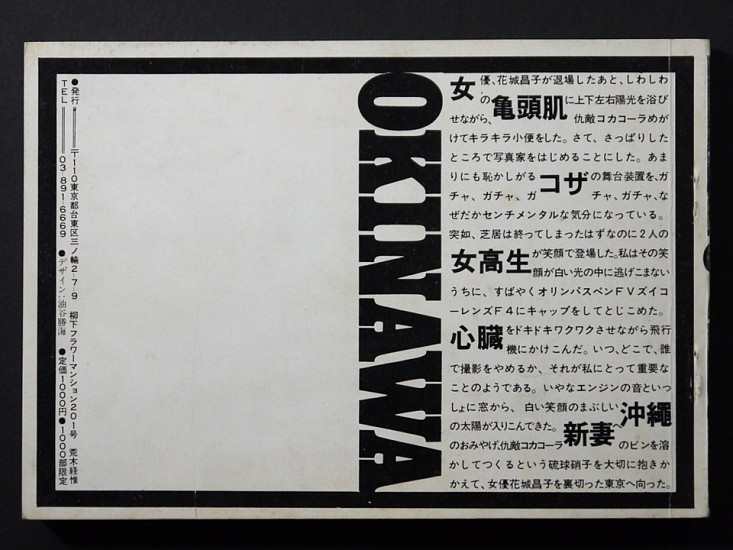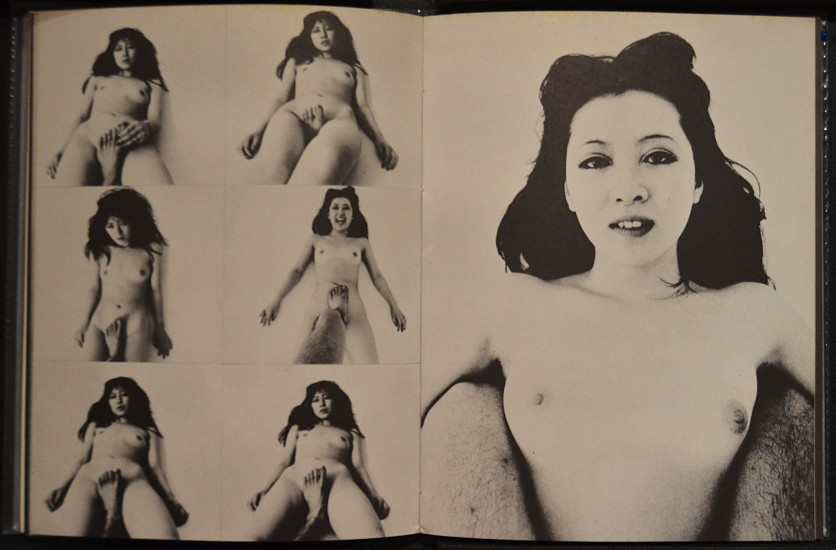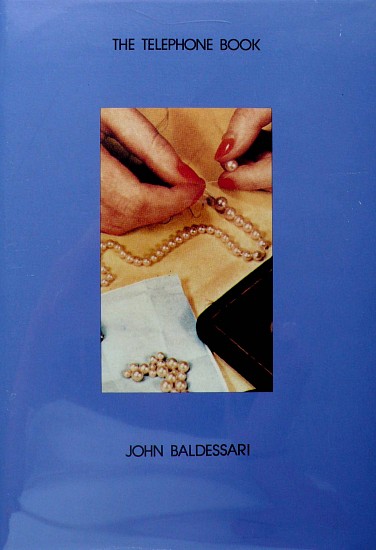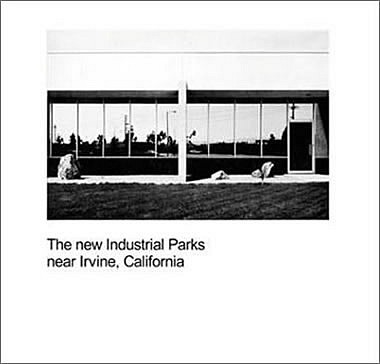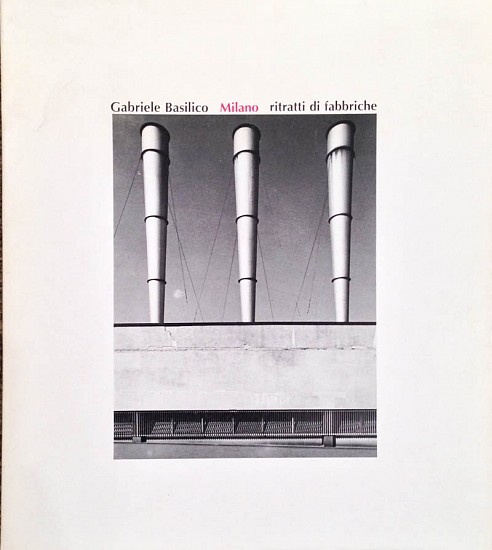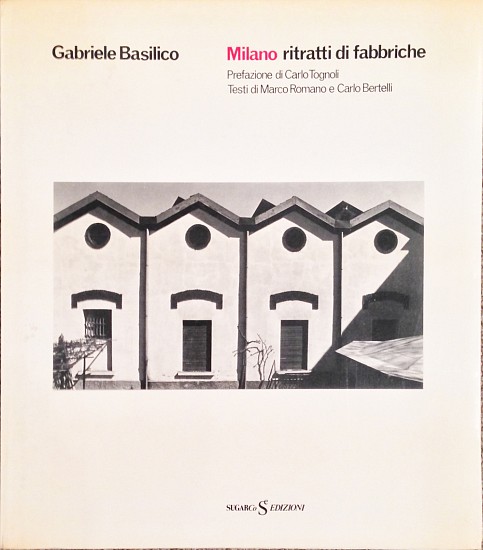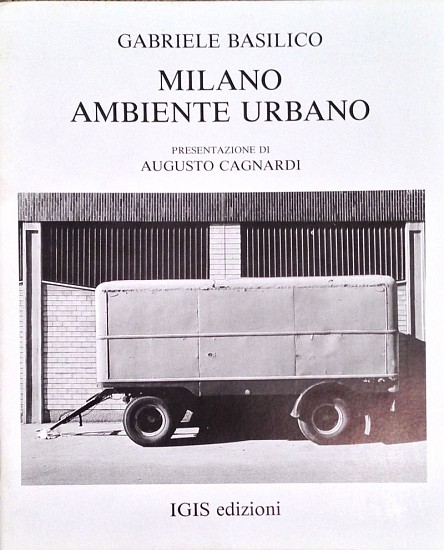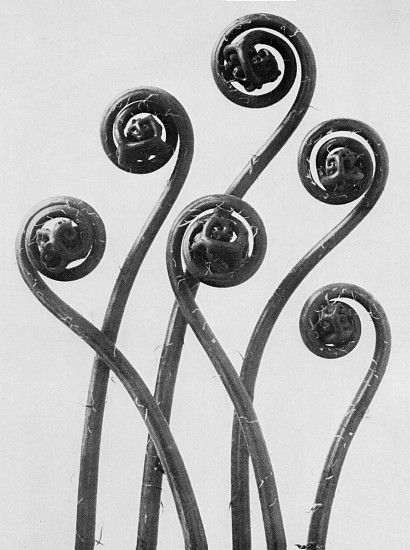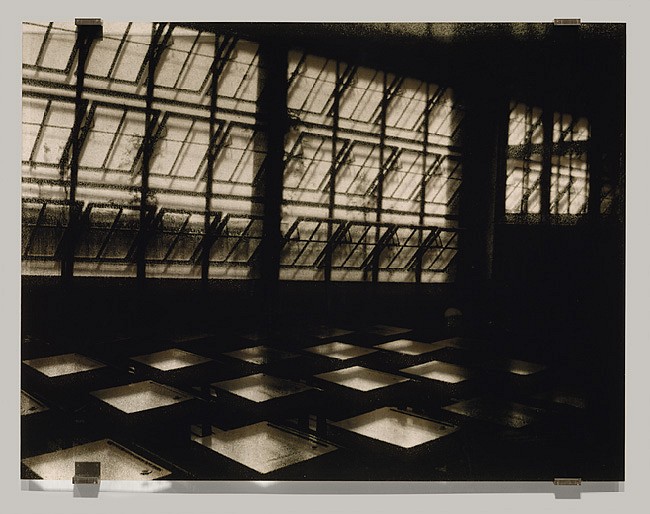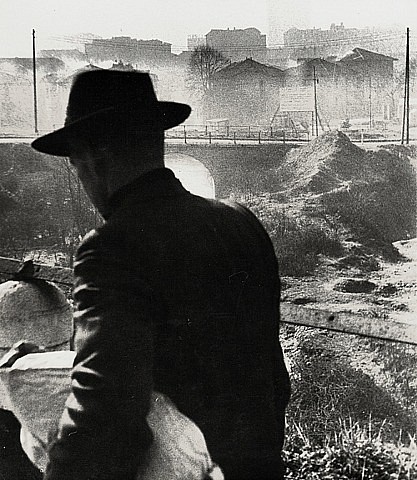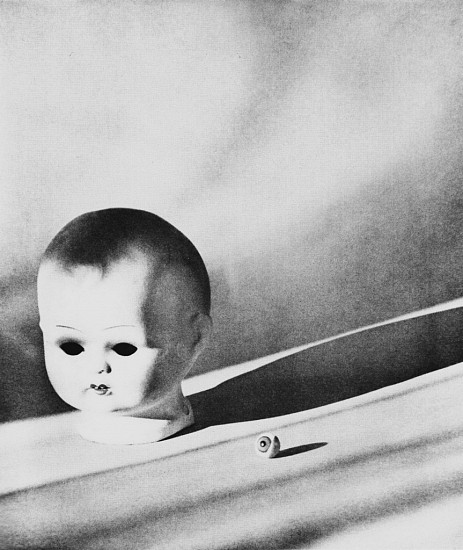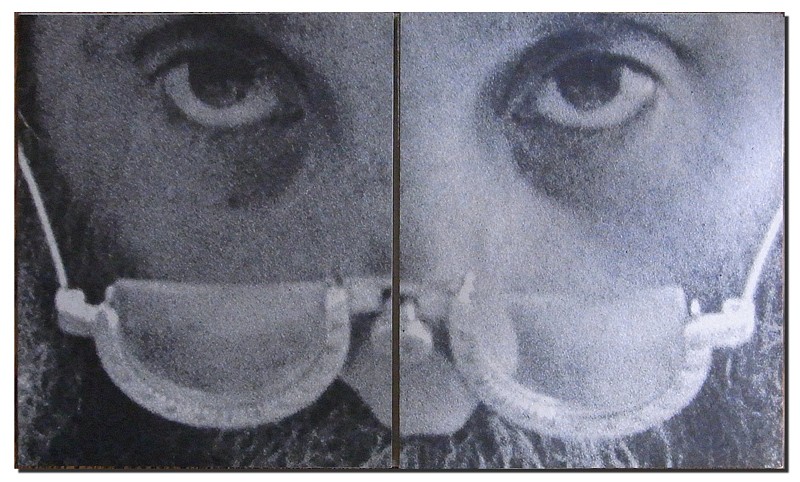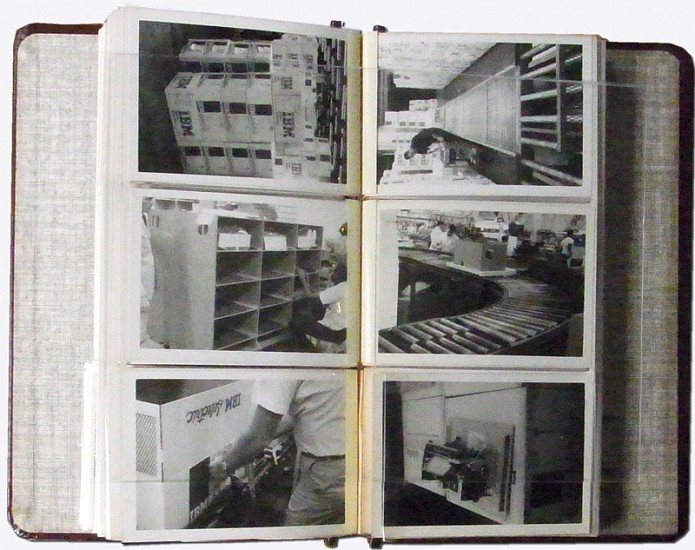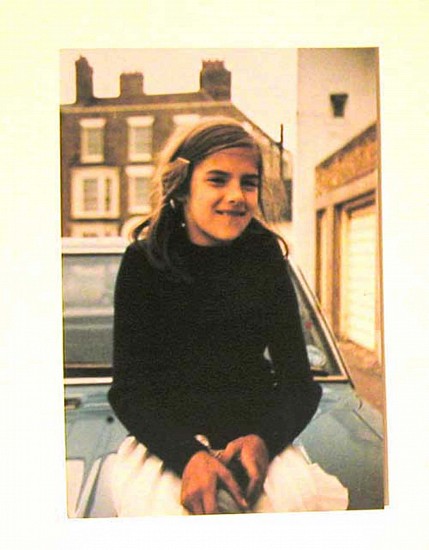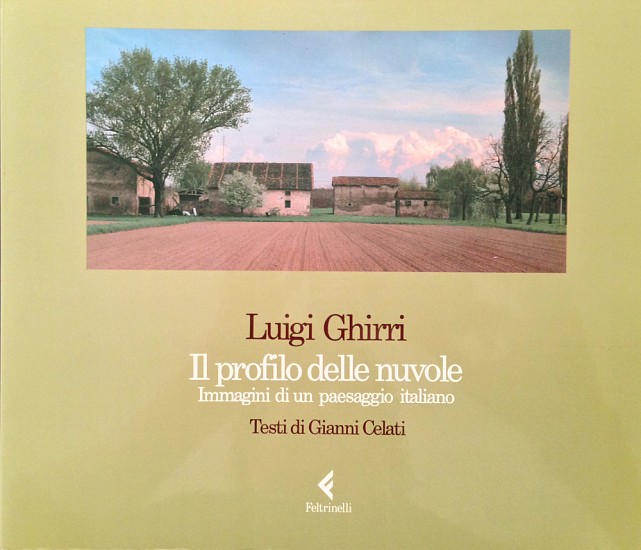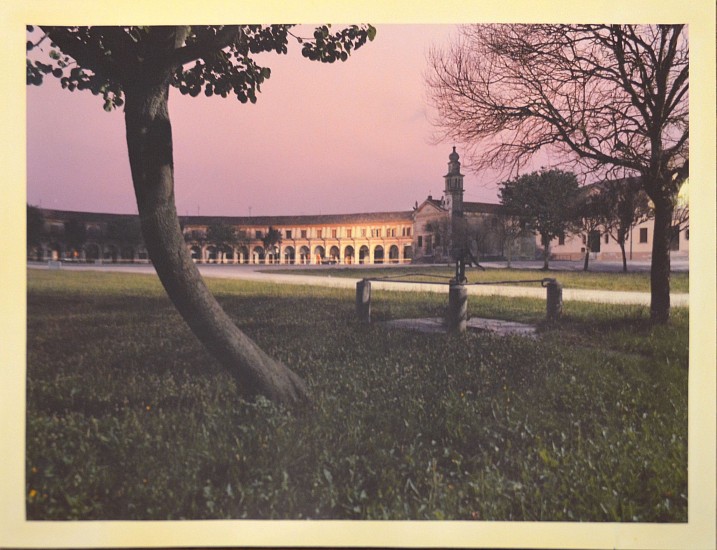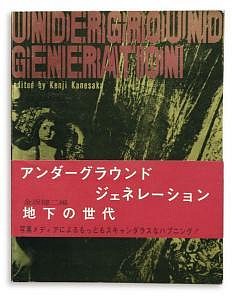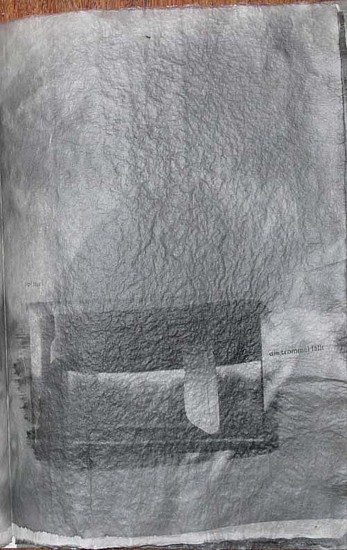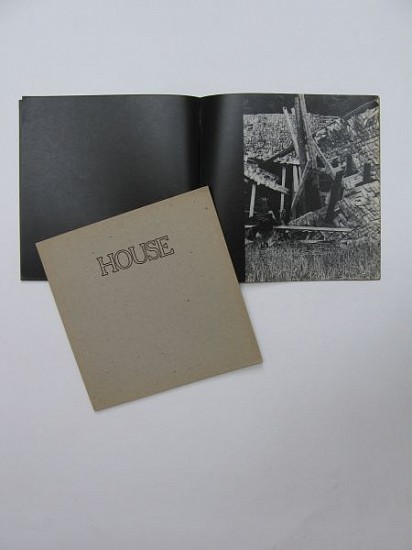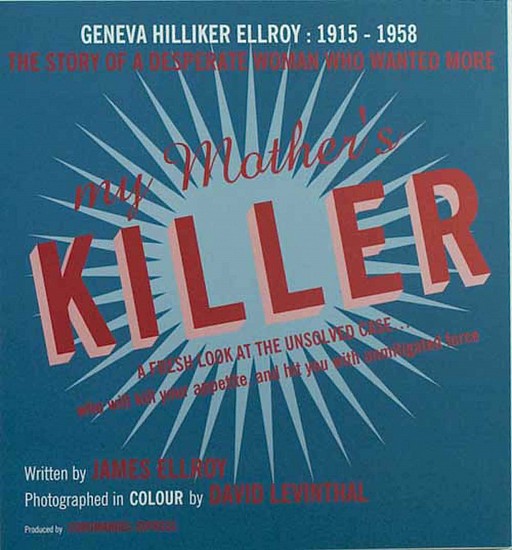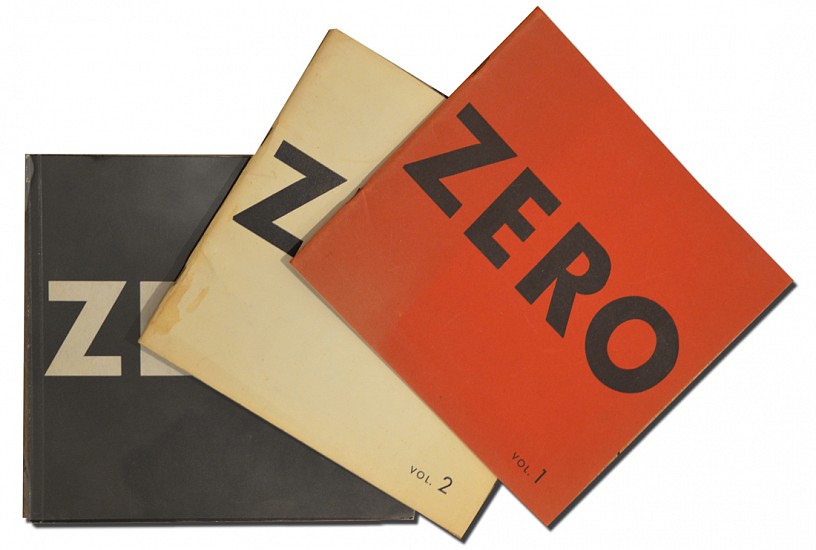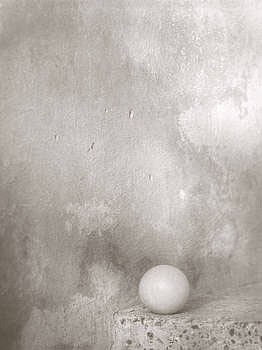Paris Photo Paris 2013
Noboyoshi Araki
Midori, 1982
1916
Paperback with printed cover. Photographs by Araki. The photographs in Midori possess technical qualities, in particular a sharpness of grain, not present in Araki's previous work. The book's title references a classical heroine of that name from Japanese literature of the Meiji era. The heroine is portrayed here as a discreet young woman.
Price Upon Request
Noboyoshi Araki
Tokyo, 1973
1761
First Edition. Thin quarto. The third book in the Sentimental Journey series, published by Araki under the auspices of the Geribara 5. "An expressionless city and a violent eroticism." (Koharto 71). The book follows a simple pattern: pink endpapers, no text, images on rectos only. Shots of bored or at best vaguely bemused pedestrians juxtaposed with women masturbating, or their fingers in condoms, or sucking bananas, etc. Photographed in a minimalist style that only heightens the mix. One of Araki's best and scarcest books. A little wear at the spine, else near fine in printed wrappers. While in many aspects, this work is a synthesis between previous two works, "Oh, Nippon"; and "Okinawa...". We find here the esoteric character of the first and association of the images in order to create singularity of the second. However, this time around, it's Tokyo that is the subject matter and the crowds streaming through its arteries.
Price Upon Request
Noboyoshi Araki
Okinawa: Araki Nobuyoshi Shashinshu 2, Zoku Senchimentaru na tabi (Araki Nobuyoshi Photobook 2, Sentimental Journey continued), 1971
1756
7 1/8 x 5 in. (18 x 12.6 cm)
Tokyo: Self-published by the artist.
Published in an edition of 1000 unnumbered copies. Original wrappers, printed in black-and-white on both front and back covers. With 200 black-and-white photographs printed in offset. Design by Katsumi Yutani.
This copy is signed by Araki in blue pen on the first page, and includes with a drawing of a three-trunked elephant.
This is the second of the loose trilogy of privately printed books produced by Araki, preceded by Sentimental Journey (1971) and followed by Tokyo (1973). Araki took the photographs for this book during a visit to Okinawa, where he was working on a poster campaign for the Japanese Government to mark the return of Okinawa Island to Japanese administration after 27 years of United States control. Although the title suggests that it is a continuation of the work he made of his honeymoon in Sentimental Journey, the work is, in fact, unrelated and consists of a series of street scenes, some nudes and only a few photographs of his wife Yoko.
Two photographs are printed horizontally across each spread of this small-format book, with no partitioning space between them. A wide amount of white space surrounds these pairs of photographs, reinforcing the idea that they should be considered simultaneously, or even as one continuous image. Many of the images include advertisements and other photographs within the frame, such as the opening shot, which shows August Sander's photograph of two young boxers on the cover of Camera magazine.
[Ref. Andrew Roth, The Open Book: A History of the Photographic Book from 1878 to the Present, pp. 270-1; Ryuichi Kaneko & Ivan Vartanian, Japanese Photobooks of the 1960s and '70s, p. 114]
Price Upon Request
Noboyoshi Araki
Oo Nippon (Oh Japan!), 1971
1902
10 5/8 x 8 1/8 in. (27 x 20.5 cm)
Tokyo: Mikishuppan. 255 black and white photographs printed using the heliogravure method. Original colour photo-illustrated self-wraps. Paperback with printed cover. Text by Uchida Eiichi. The strong erotic element of this work would become a characteristic of Araki's style. Female models are photographed nude in front of plain background and organised in sequence. Pubic hair is, in conformity with censorship laws, covered with dark marker pen.
Price Upon Request
John Baldessari
The Telephone Book (With Pearls), 1988
1704
8 1/4 x 5 3/4 in. (21 x 14.8 cm)
The book features a series of cropped movie stills depicting either a telephone or pearls. Signed and dated by the artist in pen. 62 pages, unpaginated, including 43 black and white illustrations, some with color spots. Gent, Belgium: Imschoot, Uitgevers for IC, 1988. First Edition. 8vo, wraps
Price Upon Request
Lewis Baltz
The new Industrial Parks near Irvine, California., 1974
2109
8 7/8 x 10 in. (22.5 x 25.4 cm)
First Edition Thus. Oblong 4to. Printed Buckram in Dust Jacket. Photography Monograph. Near Fine/Near Fine. np (110pp), 51 duotone illustrations. Designed by Thomas F. Barrow. Text in English and German. "The New Industrial Parks Near Irvine, California" is Lewis Baltz' landmark typological study that virtually single-handedly gave birth to the "New Topographics" movement. It reproduces as a full page each of the fifty-one images that comprised the 1974 Castelli Graphics photographic print portfolio of the same name that was issued in an edition of forty with six artist's proofs. A bright, most handsome example of the uncommon 1974 first printing (cited on pages 298-299 of The Hasselblad Center's "The Open Book", and pages 228-229 of "The Book of 101 Books").
In 1975, the year he published his first book , ‘The new Industrial Parks near Irvine, California,’ Lewis Baltz was also included in a landmark exhibition at the International Museum of Photography at George Eastman House called ‘New Topographics: Photographs of a Man-Altered Landscape.’ Although some of the participants in that show managed to elude the label, Baltz--along with Robert Adams, Stephen Shore, Henry Wessel, Jr., and Bernd and Hilla Becher--was effectively branded, and ‘The New Industrial Parks’ was paired with Adams’ 1974 ‘The New West’ as the most cogent, concise, and rigorous New Topographics documents produced in America. The label stuck primarily because it was invented to describe exactly what California-born Baltz had been doing since the late ‘60s: photograph the American landscape as a dead zone. Tamed, flattened and sectioned off into building sites and real-estate opportunities, Baltz’s New West--most of it located in California’s vast suburban sprawl--had long since lost any memory of magnificence and promise. In their place was the alluring vacuum of anonymity (though that seems beside the point in pictures devoid of any human presence) and desolation so complete it was almost elegant. Baltz had honed in on that austere, unlikely beauty in his earlier series on tract homes, but he refined his vision for the Irvine series, which focuses on the fac¸ades of windowless office blocks and electronics factories, some still in construction on barren lots, others landscaped as perfunctorily as a toll plaza.... [Unlike] Ed Ruscha’s genuinely artless images of apartment buildings and parking lots, Baltz’s pictures are pointedly artful. The Irvine series, though (presumably) despairing of the industrial parks’ cold emptiness, can’t help but establish its link to minimalist painting and sculpture, particularly Donald Judd’s boxes and Carl Andre’s concrete blocks†(Vince Aletti, in Roth): Thomas F. Barrow. Signed and inscribed by L. Baltz.
Price Upon Request
Gabriele Basilico
MIlano ritratti di fabbriche, 1981
4371-BK
10 3/8 x 9 1/2 in. (26.5 x 24 cm)
4th book with text by Tognoli
Price Upon Request
Gabriele Basilico
MIlano ritratti di fabbriche, 1981
4372-BK
10 5/8 x 9 1/2 in. (27 x 24 cm)
6th book with inscription
Price Upon Request
Gabriele Basilico
Milano Ambiente Urbano, 1978
4370-BK
with text by Augusto Cagnardi
Price Upon Request
Karl Blossfeldt
First Forms of Art, 1930
4365-BK
Title and contents page, 80 photographs on 40 sheets after Karl Blossfeldt, contents loose as issued. Publisher's half cloth over patterned paper covered boards, yellow title label on the upper cover, silk tie (Library blindstamp). Printed from the original glass negatives.
Price Upon Request
Bruno Munari and Ugo Mulas
Campo Urbano, 1969
4374-BK
11 5/8 x 7 5/8 in. (29.5 x 19.5 cm)
In Campo Urbano (1969) Ugo Mulas (1938-1973) disbands with conventional divisions between documentation, portraiture, and artwork by employing tilted camera angles, unusual framing, and a series of images that visually describe a daylong intervention in the city of Como. The work foreshadows his later engagement with the conceptual side of photography, its framing and mirroring of the world.
Price Upon Request
Jean-Marc Bustamante
Lumieres, 1994
1965
From 1987-93 Bustamante started a new series, 'Lumières', which are large black and white photographs, silkscreened onto plexiglass, and hung with four metallic hooks which maintain the image at a distance of about 10cm from the wall. The effect obtained is that the image is both projected onto the wall and reflected in the plexiglass - hence disturbing the viewer's vision. The viewer is confronted with an inderterminate space which cannot be focused on properly. In the most recent series 'Aérogrammes'(1997) and 'Panoramas'(1998) the artist begins to explore a similar effect of uncertainty between space and surface - architecture and photography - with monochromatic colours and drawing.
Price Upon Request
Mario Carrieri
MIlano, Italia, 1959
3785-BK
11 3/8 x 10 1/8 in. (29 x 25.8 cm)
135 black-and-white photographs printed in gravure, design by Giulio Confalonieri, Ilio Negri and Giuseppe Trevisani. . First edition. Carrieri was a leading photojournalist and cinematographer associated with the Italian neorealists. He was influenced by William Klein's 'Life is Good & Good For You in New York' and shared a similarly raw view, though his layout is slightly more restrained. Carrieri spent time photographing in the suburbs as well as in the centre of Milan, focusing his attention mostly on the less glamorous working side of this hard Italian city. 'One of the most important works of the neo-realist tendency of the 1950s' (Parr). In the same year as Milano, Italia, Klein published his own impressions of Italy in Rome: The City and Its People. [Parr, M. and Badger, G., The Photobook: A History Vol.I, p.214].
Price Upon Request
Giuseppe Cavalli
Immagini, Volume 1, 1946
4366-BK
Portfolio of 20 prints, published by the Istituto Italiano Arti Grafiche, Bergamo
Price Upon Request
Cesar
Rétrospective des sculptures. Overzichtstentoonstelling van sculpturen. with 9 cadrages sur César., 1976
2332
9 5/8 x 9 7/8 in. (24.5 x 25 cm)
Limited edition. 2 volumes. pages: (Vol.I): 132. (Vol.II): 9 (folded plates). illustrations: b/w. bound with screws, 25 x 21 cm. Traveling exhibition: Grenoble, Knokke, Rotterdam, Paris. Second volume: 9 cadrages sur César: Photographie: Carrara. Tiré à la main. Numbered copy, signed by the artist. Text in French and Dutch. Very good copy. artists monographs sculpture art after 1940 photography
Price Upon Request
Artistes Divers JAP PH
Minox Print Album. Photograph Album Documenting Primarily Manufacturing Packaging Areas at Various IBM Facilities., 1966
3718-BK
9 1/2 x 5 7/8 in. (24 x 15 cm)
International Business Machines, 1966. First Edition. Hard Cover. Very Good A collection of photographs, primarily 3 x 4 inches, in an old Minox Print Album, documenting various IBM facilities, mostly related to final packaging of equipment. The album sleeves are coming apart, and would benefit from relocation into another format. The photos themselves are generally in good shape with good contrast. We left them in this album to preserve their order. A few images have been removed (if ever there). First section marked "IBM Poughkeepsie, September 1966", 30+ images, including many cardboard boxes after final closure with names like Friden, Doehler-Jarvis Division, Arden Farm and IBM. One appears to be a punch-card machine read to go. Next section marked "IBM Lexington, September 1966", 32+ images, including images of styrofoam like packaging, and images include typewriters (some on the end of a conveyor line), some marked IBM Electric Typewriter and IBM Selectric, some in and out of boxes. This section appears to show final packaging and how it was done - what we think are air guns, various cardboard/styrofoam packaging components, some people processing typewriters off the line, etc. The next section is marked "IBM Endicott, September 1966", 20+ images, some boxes marked "IBM Systems Manufacturing". We see what appear to be high-speed line printers, reel-to -reel tape drives, and smaller terminal printers in this group. There is also a pocket in rear with some very small negatives (a quick view appears to be more than half family images, with a few that might be manufacturing related, though what and where we can't tell. Perhaps these are clues to the owner if blown up to viewable size. In our experience photograph albums that document any portion of the computer industry are scarce on the market. These don't appear to be professional images (some of the images aren't exactly complementary from a packaging perspective) and are likely to have been taken by someone who worked there or a tour group member.
Price Upon Request
Tracy Emin
Exploration of the Soul, 1994
906
8 x 8 in. (20.3 x 20.3 cm)
Signed on inside with two original color photographs. Book is housed in a hand sewn white cloth bag with yellow letters "TE". Sold to fund a road trip undertaken by the artist from San Francisco to New York. Emin sold the book at galleries and other venues where she would give one-night performances reading from it.
Price Upon Request
Luigi Ghirri
Il profilo delle nuvole, 1989
4369-BK
8 5/8 x 8 7/8 in. (22 x 22.5 cm)
Soft cover- Luigi Ghirri (5 January 1943 1992) was an Italian photographer. Born in Scandiano, Ghirri began taking photographs in 1970, mostly working in a milieu of conceptual artists. From 1983 he focussed primarily on photographing architecture and the Italian landscape. Ghirri also was notable for organising such exhibitions as Iconicittà (1980), Viaggio in Italia (1984), and Esplorazioni sull via Emilia (1986). He worked for the Architectural Section of the third Venice Biennale of Architecture (1985), which was directed by Aldo Rossi, and the Milan Triennale (1988). Ghirri's books include Paesaggio italiano/Italian Landscape (1989) and Il profilo delle nuvole (1989). A rare title of one of the best known italian photographer. "Ghirri uses space, place, and landscape to question our relation to the external world and its representations, and to revalue the role of photography and art. In particular, Ghirri's poetics of space moves from insistent decontextualization and estrangement to a notion of affective space, combining a sense of inhabiting with one of errance, a fascination with the new with a nostalgia for the old and the marginal, and a critique of contemporary society with an attachment to a sense of place and of the individual as vanishing traces.", Marina Spunta in Italian Studies, Volume 61, Number 1, Spring 2006, pp. 114-136(23).
Price Upon Request
Luigi Ghirri
Piazza Badaore, 1986, 1989
3450-OR
15 1/8 x 11 5/8 in. (38.5 x 29.5 cm)
Original picture exposed at the Venic Biennale. from the serie of paesaggio Italian. Luigi Ghirri (5 January 1943 1992) was an Italian photographer. Born in Scandiano, Ghirri began taking photographs in 1970, mostly working in a milieu of conceptual artists. From 1983 he focussed primarily on photographing architecture and the Italian landscape. Ghirri also was notable for organising such exhibitions as Iconicittà (1980), Viaggio in Italia (1984), and Esplorazioni sull via Emilia (1986). He worked for the Architectural Section of the third Venice Biennale of Architecture (1985), which was directed by Aldo Rossi, and the Milan Triennale (1988). Ghirri's books include Paesaggio italiano/Italian Landscape (1989) and Il profilo delle nuvole (1989).
Sold
Andreas Gursky
Montparnasse, 1995
3668-BK
19 1/2 x 11 in. (49.5 x 28 cm)
Two square quarto vols., and oblong folio photo-reproduction. Original silver coated wrappers, printed in black, original silver coated portfolio, printed in black, all laid into the original silver papered box. A fine copy, with the print in fine condition. First edition, offset lithograph in color, on wove paper, with text book and book of reproduction of blown up images. Andreas Gursky is a German photographer best known for his vast color architectural landscapes. His point of view is often so far from the object that it is difficult to tell what it is. In this photograph, hundreds of windows simply become tiny squares and lose their meaning as architecture.
Sold
Kenji Kanesaka
Underground Generation, 1968
1748
11 1/8 x 8 5/8 in. (28.4 x 22.1 cm)
Tokyo: Novel Shobo
100 black-and-white photographs printed in offset. Original foil card wrappers, with printed bellyband.
This early collective publication, focusing on the then emergent art scene in Japan, features work by many of those who became the key photographers of post-war Japan, including Daido Moriyama, Masahisa Fukase, Eikoh Hosoe, Jun Morinaga, and Kenji Ishiguro. Some of Kanesaka’s own photography is included, though his primary role was that of editor. His agenda was to create a visual pastiche of the underground scene, and the growing influence of the youth culture movement in Japan. The inspiration of Andy Warhol's Index (Book), which had been published the previous year, is evident in the book’s chaotic collaged layout, with images placed directly up against each other, or overlapping, or rotated. The fragmented visual styling of Underground Generation is also indicative of the influence of the book’s co-editor, Takuma Nakahira, who in the same year was to publish his seminal Provoke periodical.
[Ref. Ryuichi Kaneko & Ivan Vartanian, Japanese Photobooks of the 1960s and '70s, pp. 136-139]
Price Upon Request
Stephan Kohler
Ein Gedicht fur ein buch, 1996
1690
A collaboration of the writer Yoko Tawada, the artist Stephan Köhler and the bookdesigner Clemens-Tobias Lange; This artists' book is a tautologic work, it is on reading, on artistic process. There are only a few words on pagefilling silver-gelatine printed sheets. The photographs by Köhler are painted on the translucent and crispy medium. Photoemulsion and letterpress on handmade japanese paper. Bound in natural colour ray-skin (Galuschat) by Thomas Zwang. Edition: 45 + XV e.a.
Price Upon Request
Ugo la Pietra
AD OGNUNO LA PROPRIA REALTA"To each his own Reality", 1972-74
4380-BK
16 x 12 in. (40.5 x 30.5 cm)
A conceptual artists book with original photographs throughout, published by Jalik & Colophon in an edition of only 30 copies which were never completed, this is copy #1/30 and comes directly from the Artist. 40,5 x 30,5 cm. In the Sixties Ugo La Pietra was one of the first artists to use photography as a medium for artistic operations. His images, often composed and integrated by written and manual intervention, are the result of a careful exploration of the contradictions of life and living. These images, starting from the urban environment degraded and alienating, change the perspective, the perception and our way of life, to make out beauty, possibility of intervention and change, happiness.
Price Upon Request
Le Corbusier
Aircraft, 1935
3484-BK
9 7/8 x 7 5/8 in. (25.2 x 19.4 cm)
92 pages, 16 of text with 124 illustrations, most being photographs and some are reproduced drawings.
Published by The Studio, London.
Aircraft celebrates flight and casts the airplane as the pinnacle of modern technological achievement. The book captures the enthusiasm and ideas surrounding the aerial age. Le Corbusier opens the book by emphasizing the “ecstatic feeling†that flight produces in him. It is “symbol of the New Ageâ€, promising adventure, progress and wild possibility. He idealizes the aesthetics of the machines, too, which possess “clearness of function†(a core principle that underpinned Le Corbusier’s utopian architectural schemes). Le Corbusier’s captions are typically bold and uncompromising. The text that accompanies image 9, for example, reads: “The bird’s eye view … man will make use of it to conceive new aims. Cities will arise out of their ashes.â€
Reference: Fotografia Publica 132, p.81; Le Corbusier et le livre, p.122
Price Upon Request
Les Levine
House, 1971
4375-BK
Square 4to.; unpaginated; illustrated throughout in b+w; tan wrappers printed in black; included with 24 b+w photographs originally used in production of the book. Each photo is 6 x 9 ½ inches, each individually mounted to thick board; housed in custom cloth box. Fine. First edition. Les Levine’s House is a tongue-in-cheek sendup of Minimalist/Conceptualist art practice in which Levine designates a series of photos of a collapsed house as a “working plan for a sculpture or monument.†Anyone choosing to undertake the project is instructed to work “according to the scale of the space he finds available†and to send photos of the finished work to Levine. Published by Hilversum: Steendrukkerij de Jong & Co., 1971.
Price Upon Request
David Levinthal
my Mother's KILLER, 1998
1377
Unpublished text by James Ellroy and 7 signed color photographs of miniature scenarios by Levinthal housed in a blue slipcase. mint condition.
Price Upon Request
Multiple Artists IT
Zero Set 1 + 2 +3, 1958-61
4137-BK
Full Set of Zero magazine. Manifestos were often published in association with the shows, such as Zero 1 (1958), Zero 2 (1958), and Zero 3 (1961). These included texts in multiple languages written by artists and curators active in the Zero circle who sought to define what they termed "The New Artistic Conception." Otto Piene said Zero was "a zone of silence and of pure possibilities for a new beginning."
Price Upon Request
Multiple Artists IT
Complete set of Immagini(1-3), 1946
4381-BK
12 1/4 x 9 1/4 in. (31 x 23.5 cm)
Each portfolio of 20 prints, published by the Istituto Italiano Arti Grafiche, Bergamo.Volume one is by Cavalli, two by Vender and three is by various artists titledf Mountains. Very rare to see complete in fine condition.
Price Upon Request





























